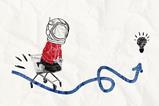Harness this powerful tool to improve retrieval and problem solving and indicate how well students understand concepts

One of the most challenging things we ask our students to do is convert a string of spoken or written words into a dynamic 3D model in their minds.
Chemistry is full of models involving particles, charges, energy and potentials. These models are three-dimensional, dynamic and abstract. The best option for understanding them is often a physical model, but it’s tricky to make a model showing energy and charge, and models are expensive. Diagrams are quick and easy to draw or project, and they are sometimes animated, but you can’t usually manipulate them.
Finally, you’ve got words. Fine for explaining things where the steps happen one at a time, but it’s easy to overload your students’ working memories. If only there was a quick and easy method which is easy to learn and always available. Good news – there is.
When you watch a chemistry teacher explain something, look at their hands: there’s something miraculous going on. Without any additional thought, the teacher is providing a complex three-dimensional, animated subtitle while they explain: gestures. And equally miraculous – students can ‘read’ these gestures without conscious thought, combining them with the words to understand better.
Psychologists have carried out countless investigations into the power of gestures to explain, and found that gestures are not only useful for communicating complex abstract ideas, they also help with memory, teacher assessment and problem solving. All you need to do to benefit is be aware.
The first useful thing to know is how gestures are categorised. The first main category of gestures is used to represent 3D models. These representational gestures can be categorised further:
- Deictic gestures are used to point to imagined objects, for example pointing to imagined ions in a crystal.
- Iconic gestures represent actions and motion, for example electrons being transferred in a chemical reaction.
- Metaphoric gestures are used to point to abstract ideas, such as energy levels.
Gestures can also be used like bullet points or items in a flow diagram to show sequences. These gestures are called beats.
Research has shown that when teachers gesture, their students remember more. And gesturing isn’t just helpful for communicating from teacher to student. When students gesture while explaining to a partner, their later retrieval also increases.
Recently, I was in a year 4 maths lesson. The teacher uses ‘Turn and talk’ a lot and when he asked the students to explain a concept to their partners, they all did so with confidence and enthusiasm. The striking thing was that none of the students gestured.
Is this a problem? Research suggests it might be. When students gesture during encoding (learning new knowledge), they remember more weeks later. And this is true whether they gesture unprompted or are instructed to gesture. So, if your students aren’t spontaneously gesturing during encoding, encourage them to do so.
Improving problem solving
When a problem involves remembering the position of several things – such as the movement of electrons in a reaction – we often use our hands to keep track of positions. This is usually spontaneous and happens even when we are the only person present.
Gesturing helps reduce cognitive load. If your students are struggling to keep track of items while problem solving, it may be worth suggesting they use their hands to model the situation.
Examples where gesturing might support problem solving in chemistry include: following the motion of ions in electrolysis, describing the structure of polymers, explaining polymerisation, displacement reactions, SN2 reactions and bond vibrations.
Gesturing not only helps us keep track of complex interactions, it can also help us apply a strategy to new contexts (known as far-transfer). In one experiment, students were split into three groups. The first group were encouraged to physically move objects (blocks or cards) to solve problems. These students were able to recall the same method well, but as soon as the problem changed, even a little, the group coped less well.
The second group were encouraged to mime the movement of the physical objects. These students performed just as well as the group using physical objects, but surprisingly, they outperformed them when the problem was changed slightly.
The greatest impact on far-transfer happened in the third group. They were trained to make abstract gestures when solving the problems, pointing rather than miming the movement. These students were able to solve far-transfer problems almost as well as they could near-transfer ones, demonstrating that abstract gestures have a powerful effect on problem solving.
Assessing understanding
Use of gestures in the classroom is also a handy assessment tool. It turns out that when students are on the cusp of understanding a concept, correct gestures precede words. When a teacher notices that a student’s gestures are correct (eg gesturing how electrons are transferred in a reaction) when the words are not yet correct, the student is close to ‘getting it’.
Implementing gestures
Gesturing is a powerful tool in the classroom. It helps teachers explain and assess, and helps students recall information and solve problems more efficiently. The great news is that you don’t need special training to make better use of gestures for learning, you just need to know that each effect exists. Consider yourself trained!
Encouraging gestures in class does not need to take time. You are probably already using gestures, just make sure your students are watching you. Draw their attention to how you are using your hands during problem solving and encourage them to do the same – make it seem normal. Finally, watch your students’ hands when they are explaining – their hands will tell you whether they understand something more reliably than their words.
For further information about how action shapes thought, read Mind in Motion by Barbara Tversky or watch her YouTube lecture.
Ben Rogers is an ex-physics teacher and leads on pedagogy, curriculum and assessment at Paradigm Trust














1 Reader's comment